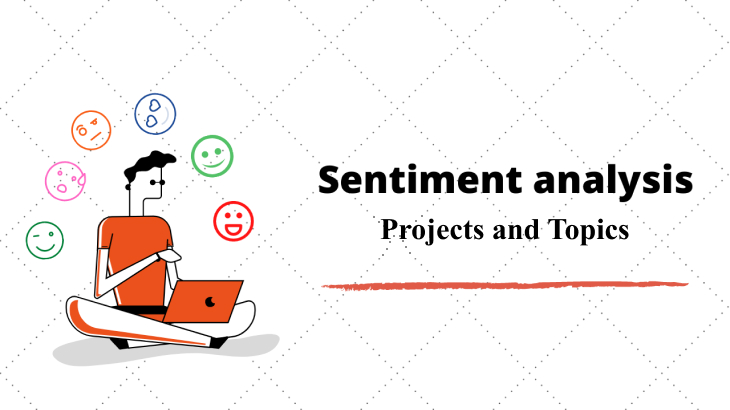Emotions are crucial in both personal and professional life. You can review and enhance the business, marketing, and communications strategy by considering how your target market and customers feel about your products or brand. Using sentiment analysis or opinion mining, researchers and businesses can gain insights from user-generated social media and web content.
Regardless of the sector or vertical, it is now crucial to understand how consumers feel about brands and products. More than a dull, generic resume might be required for the fierce competition for high-paying positions in the NLP and ML market. Instead, working on a sentiment analysis project using real datasets will make your application stand out and increase the likelihood that your desired employer will contact you.
Introduction Sentiment Analysis
What is Sentiment Analysis? With the use of natural language, machine learning, and other data analytics approaches, sentiment analysis is used to examine the raw text to produce objective, quantitative results. It is used to identify positive or negative sentiments in text, and companies frequently employ it to determine the reputation of their brands with huge demand.
Types of Sentiment Analysis
There are different sorts of sentiment analysis where the models concentrate on intents, polarity, urgency, and feelings and emotions.
1. Fine-grained sentiment analysis
2. Multilingual sentiment analysis
3. Emotion detection
4. Aspect-based sentiment analysis
Sentiment analysis is essential because it aids companies in comprehending the feelings and sentiments of their clients. Businesses use social media conversations and reviews to understand customer opinions to make more educated decisions.
By 2027, it is expected that the market for sentiment analysis software will have grown to US$4.3 billion. The market for sentiment analysis will grow at a CAGR of 14% by 2023.
Types of Sentiment Analysis
Fine-Grained Sentiment Analysis
You can utilize fine-grained analysis if you need more accurate results. Applying fine-grained analysis at the level of the sub-sentence is intended to pinpoint the sentiment's target topic. Each phrase or clause in a sentence is broken down and examined concerning the others.
Multilingual Sentiment Analysis
Multilingual sentiment analysis means performing sentiment scoring in more than one language. The tricky thing about sentiments is that our culture and language greatly influence our emotions and consumer behavior.
Emotion Detecting Sentiment Analysis
This sentiment analysis pinpoints emotions, including rage, joy, and melancholy. You'll frequently employ lexicons to identify emotions. Lexicons also have limitations. Thus, in certain circumstances, you need to utilize ML techniques.
Aspect-Based Sentiment Analysis
Element-based sentiment analysis examines the aspect of the topic that people are discussing. If you have reviews of a smartphone, you might be curious to know how long the battery lasts or how big the screen is.
Benefits of Sentiment Analysis
Real-Time Analysis
Real-time identification of pressing problems is aided. Is a social media problem, for instance, getting worse? Is a consumer about to become enraged? Businesses can quickly identify client pain spots and take rapid action with the help of sentiment analysis models.
Sorting Data at Scale
Using sentiment analysis, companies may refrain from manually sifting through tens of thousands of tweets, surveys, and customer support discussions. Sentiment analysis aids organizations in efficiently processing massive amounts of data.
Consistent criteria
Since labeling text by sentiment is extraordinarily subjective and influenced by individual experiences, thoughts, and views, a centralized sentiment analysis system can increase accuracy and provide better insights.
Why Is Sentiment Analysis Required?
Why Is Sentiment Analysis Required? In their advertising campaigns, product managers can better understand client sentiments using sentiment analysis, a powerful marketing technique. It plays a significant role in consumer loyalty, satisfaction, the effectiveness of advertising and marketing, and product acceptance.
Product managers and customer success managers can more precisely change their product roadmap with the support of an understanding of consumer psychology. The phrase "emotion-based marketing" refers to a wide range of emotional consumer reactions, including "positive," "negative," "neutral," "negative," "uptight," "disgust," "frustration," and others.
Sentiment Analysis Project Ideas
Amazon Product Reviews
The first project concept for Sentiment Analysis that is appropriate for beginners involves assessing Amazon product reviews. One of the major online retailers, Amazon, offers a variety of products.
Employing sentiment analysis enables businesses to identify the aspects of their products that customers find appealing while trying to comprehend public opinion. Identifying the main problems with their products also helps.
The raw alpha-numeric text of numerous products from Amazon is scraped to start the sentiment analysis for this project. These reviews must go through a text processing stage where text is generally converted into integers using TFIDF (Term Frequency Inverse Document Frequency). A statement can be classified as "Positive" or "Negative" using a classification model like SVM (Support Vector Machines).
Since firms want specialists to apply sentiment analysis to examine their product reviews for market research, expertise in this topic is in high demand. A novice should start with less well-liked products, while those looking for a challenge should choose a well-liked product and study its reviews.
Rotten Tomatoes Movie Reviews
On the movie and television review website Rotten Tomatoes, critics and moviegoers post their opinions. You can read reviews for almost every TV show, drama, or movie worldwide on the platform. It is a sizable dataset source for the reviews' sentiment analysis.
The study of movie reviews is a classic example of a multi-class model problem since a film can elicit various emotions, including negative, somewhat unfavorable, neutral, positive, and optimistic. Emojis and other special characters can appear in movie reviews, so the extracted data must undergo data normalization.
The entertainment industry takes reviews from critics seriously, and it also assists production companies in understanding why their program or film was successful (or failed). Since consumers read reviews before purchasing movie tickets, critical reviews also affect a drama or film's commercial success. Production companies can determine the general perception of critics using sentiment analysis.
Reviews of Scientific Papers
Because of the widespread misconception that most research publications have positive citations, sentiment analysis of citation contexts in research/review papers is an untapped subject. Furthermore, criticisms are frequently hidden and are rarely apparent in negative quotations. More direct sentiment expressions are required, which is a significant obstacle to accurate polarity recognition.
Finding feelings in research articles needs both simple and complex analyses. When this occurs, rule-based analysis can categorize research papers into multiple classes by comprehending the abstracts utilizing various NLP concepts like Latent Dirichlet Allocation (LDA). LDA models are statistical models that use the "topic-model" notion to infer mathematical intuition from a collection of documents.
Track Customer Sentiment Over Time
The interests and attitudes of the customer fluctuate along with the business. Customers' feelings are impacted when firms launch new product lines or alter the prices of their goods.
You can assess and comprehend client sentiment by following their opinions over time. A change in sentiment score shows your adjustments' emotional resonance with the clients.
Companies can enhance their products and correct mistakes by monitoring favorable and unfavorable feedback.
Analyze a Company's Reputation
You can select any business to conduct a thorough opinion analysis for this intermediate sentiment analysis project. Using sentiment analysis, you can better grasp the public's perception of the company and its products.
Start by gathering information from relevant sources, such as a company's Facebook and Twitter sites, to see what the general public thinks of it. To determine the public brand perception in the market, analyze the user chats. You can scrape information from numerous review websites for a more thorough examination.
Major Advantages of Sentimental Analysis
Social Media Monitoring
To sift through the social media data and assess the general public mood on each business's social media platform, sentiment analysts must collaborate with machine learning tools. Working on these projects will provide you with experience using various learning software.
Customer Support
Sentiment analyzers use natural language understanding (NLU) to read the written text and look for meaning, tone, and emotion. Various consumer desires will be understood via the analysis. This data will be the foundation for processing emails, calls, online chats, and support tickets according to sentiment.
















Post Comments